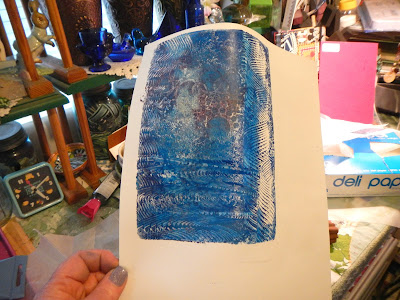MY STORY
I love adding new tools to my crafting arsenal and the gelatin printing plate from Gelli Arts is so addictive, I highly recommend it! I've summarized some different techniques below and you can see that the possibilities are endless. Stay tuned for the next blog to give you some ideas of how to create with the papers you have made.
YOUR TURN
Supplies used in these examples:
- Gelatin printing plates -- available in different sizes. For a full list of products, how-to videos visit the Gelli Arts website CLICK HERE
- Various Acrylic paints -- colors up to you. I like the line of Artists Loft paints found at Michaels
- Blank Canvas
- Plain paper ; vellum paper; watercolor paper -- they all have different effects
- Deli paper -
The deli paper is great for cleanups -- both from your brayer and if you want to remove some paint from your plate. I found mine on Amazon -- 500 sheets for a very low cost.
- Paint brayers
- Rubber Stamps
- Stencils
- Household items -- I used charms I have -- anything that will leave a texture on the plate
- Sea sponge & texturizing tool
STUDIO HINT: This can get messy. You will need some room -- I have found it easiest to use the deli paper or waxed paper under your surface. Keep baby wipes handy. Also, you use very little paint on the plate. When I first started I was putting way too much paint on. It goes a long way. When doing a printing "session" I keep using the same color palette so I don't have to constantly keep cleaning up. And some paint always remains so you get some interesting results. Once I finish, I keep my papers in files, sorted by color story, to make it easier when I want to use them. Now, let's go....
WASHI TAPE:
Washi tape is easily found and affordable. It comes in all sorts of widths and colors -- the colors don't matter, you are only using them for the pattern -- they will leave a white spot on your print.
Studio Hint: When applying the tape, leave "tails" of the edges of the plate. Will make it so much easier to remove when you are done.
STENCILS:
Stencils are a great way to achieve texture. They embed into the paint and the plate so when you lift off the paper you can get some great imagery. And remember, each print is unique.
I also applied a wash of just one color -- you still pick up some of the color which remains on the plate. Press your paper down with the stencil on top of the plate. Then remove the stencil and press another piece down. You then get the negative effect -- which could be a cool look when used together in a future project.
CHARMS
Any items you have around the house or in your stash can be used to create interesting images. They will have to be fairly flat but here is what happens with gear charms and washers from the hardware store. Also sometimes are use parts of the paper that I have already used. With a similar color story, it makes some interesting effects. This is also an example of pulling a negative image and how they can complement each other:
RUBBER STAMPS
There are a myriad of rubber stamps in the world -- I liked the effect of these decorative, deeply edged ones. They are called out as fabric stamps, but worked perfectly in these examples:
 |
| If you apply too much paint, use the deli paper to "lift" away some of the color. |
 |
| And you actually are left with a cool print |
 |
| Remove some of the paint on the stamp on a piece of paper, it may come in handy |
 |
| The stamps leave interesting impressions |
 |
| Add more texture with this tool you easily find at hardware stores |
CANVAS
I was having fun utilizing different types of paper so I had an idea of using a canvas blank as the "paper". In combination with a rubber stamp and the texture of the canvas, I love how this came out. Lots of possibilities here!!
 |
| The canvas left quite a bit a paint on the plate so don't waste it, pull another print with paper |
 |
Printing on a page you have already used can add some interesting effects.
|
I also tried fabric ink on a baby onesie. I think there is some potential here but the paint was a little too runny and not the best. It came out kind of muddy on the onesie but I definitely think there could be something here in the future!
This gelatin printing plate is so much fun to use -- you can even use regular copy paper. Since you get so many prints out of a little paint you don't have to spend alot to get custom prints. And you can use these prints in so many ways - cards, journaling pages, bookmarks.


















































































